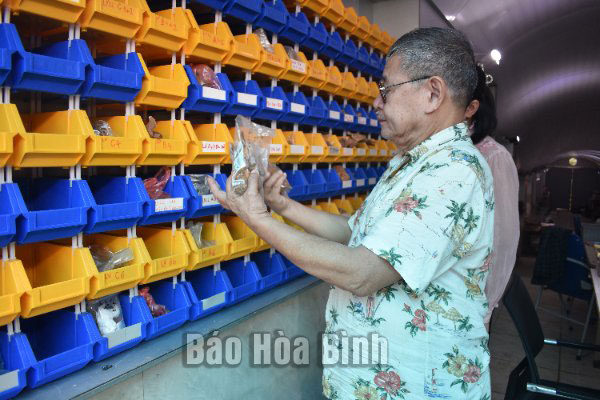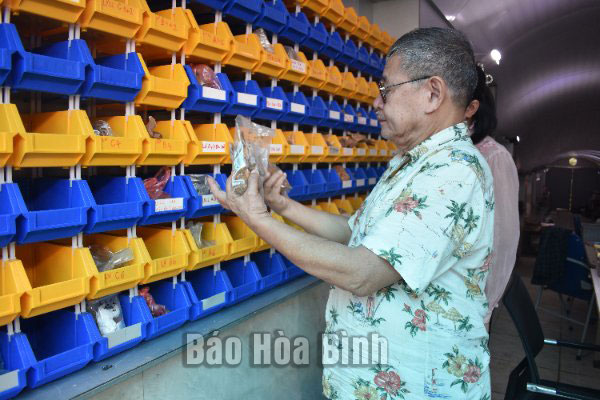
(HBO) – Through many excavations of caves and dweling places of prehistoric humans in Hoa Binh province, Dr. Nguyen Viet, Director of the Centre for Prehistoric Southeast Asian Studies, has made many discoveries of the Hoa Binh Civilisation, proving that it was much older and diverse than what have been known so far.
Dr. Nguyen Viet, Director of the Centre for
Prehistoric Southeast Asian Studies, has made many discoveries of the Hoa Binh
Civilisation.
The Hoa Binh Civilisation was discovered by
French archaeologist Madeleine Colani in 1925. She perceived that it was a
Stone Age civilisation dating back to the Holocen epoch, about 10,000 years
ago.
In 1981, a snail shell sample found in an
excavation of Trai Hamlet Cave in Tan Lap commune (Lac Son district) by the
Institute of Archaeology was sent to Berlin for examination, and the result was
astonishing: the sample was 18,400 years old plus/minus 200 years. At that
time, Dr. Chester Gorman visited Vietnam and suggested Dr. Nguyen Viet sieve
objects unearthed at Trai Hamlet Cave. As a result, hundreds of withered and
burned seeds, another hundreds of animal bone pieces, and more than 200 stone
tools dating back over 17,000 years were collected.
Findings in the sixth dig at the Trai Hamlet
Cave and the second at the Vanh Village stone shelter, carried out in 2022,
revealed that the period of 22,000 years ago was not the earliest stage of the
Hoa Binh Civilisation.
Dr. Nguyen Viet, Director of the Centre for
Prehistoric Southeast Asian Studies, said aside the new discoveries about the
age of the Hoa Binh Civilisation, researchers have also found a surprisingly
high density of artefacts at the Trai Hamlet Cave and the Vanh Village stone
shelter.
He noted there may be few places in the world
where hunters and gatherers left so many vestiges dating back to the late
Pleistocen and early Holocen epochs in. There are up to 44,000 snail shells
found at the Trai Hamlet Cave, compared to the 9,000 shells at Con Moong Cave
in Thanh Hoa province and 11,000 at Sung Sam Cave in Hanoi. The number of snail
shells discovered at the Vanh Village stone shelter is equal to that at the
Trai Hamlet Cave. Meanwhile, the number of bone pieces is about 500 per cubic
metre of deposits. Stone tools at the two relic sites number more than 70 and
300 per cubic metres of deposits, respectively.
At Trai Hamlet Cave, there are thousands of
slabs weighing 5-10kg each used as tables for preparing food and making tools.
Hundreds of tools with sharpened blades have also been found at Trai Hamlet
Cave and the Vanh Village stone shelter, and the oldest of them is about 17,000
years old, Viet went on.
One of the important discoveries at Trai Hamlet
Cave is evidence of primitive humans’ artistic mindset. Researchers unearthed
two rocks with unusual shapes in 1982 and many more in 2004, including a thin
one with zigzag and fishbone diagrams inscribed on it. In 2008, some other
rocks with similar zigzag lines were found. One of the objects collected in
2004 dates back 17,000 years ago. They represent the first artworks by humans
in Vietnam, according to the archaeologist./.
Phong Phu commune, Tan Lac district of Hoa Binh province, is widely regarded as the cultural heartland of the Muong ethnic group. Among its many traditional communities, Luy Ai hamlet (formerly Ai hamlet) stands out as a rare location where the customs and way of life of the Muong Bi people remain largely intact.
The Truong Kha temple festival, a distinctive cultural event held every three years in Vu Ban township, Lac Son district, returned recently with vibrant rituals and folk traditions of the Muong people. Located next to the Buoi River in the Muong Trao fields, the Truong Kha Temple is dedicated to the three Kun Dol deities, revered for teaching farming techniques, irrigation, weaving, and protecting the harvest.
The demand for spaces serving community activities of residents in various areas across Hoa Binh city has been satisfied as local cultural houses now feature modern, spacious facilities thanks to the effective implementation of Resolution No. 49/NQ-HDND issued on December 28, 2021 by the city People's Council, which approved the plan for reorganising, converting, and allocating land for the construction, repair, and expansion of cultural houses in Hoa Binh’s villages and residential areas until 2025.
At the end of May, the Hoa Binh Provincial Ethnic Arts Troupe organized a series of performances for residents in Region 2 and Region 3 communes across the province. Bringing art to ethnic communities in remote, isolated, and especially disadvantaged areas has become a meaningful activity. These are not merely artistic performances but also journeys to disseminate cultural values, enrich spiritual life, and contribute to preserving the cultural identity of ethnic minorities.



